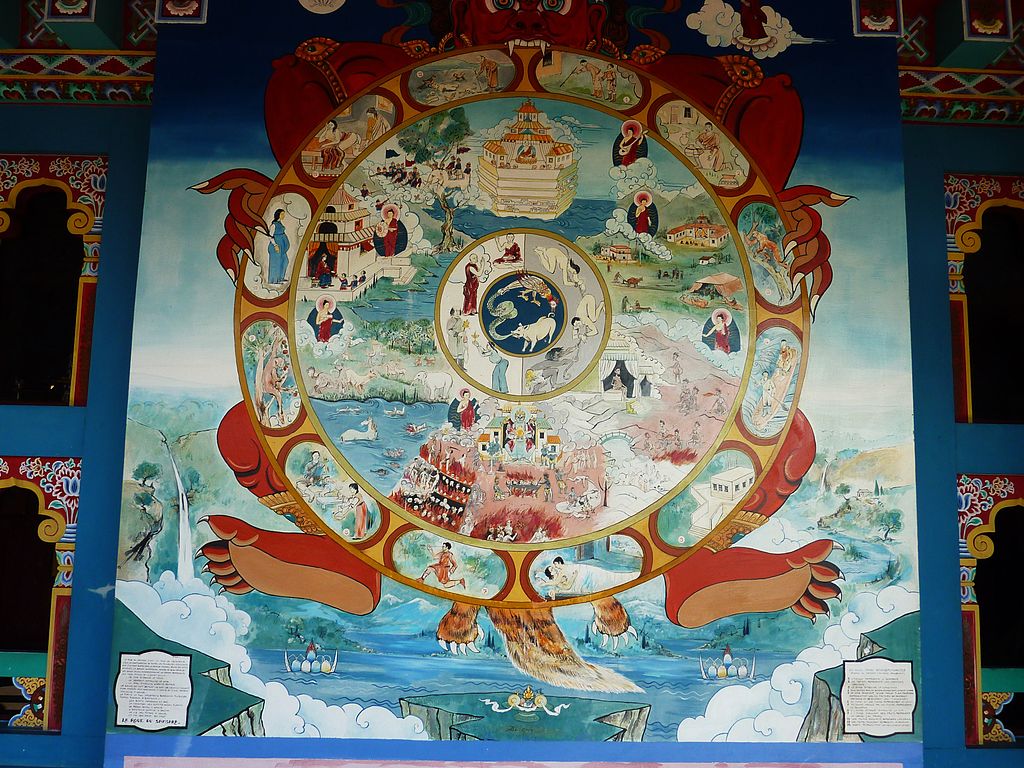
“The mythical has to be restored to the existential whence it originates in an elemental sense and within which the core of the content of its meaning can be accorded anew an existential interpretation on the dimension of Existenz … Philosophy, in contrast to science, should “restore the myth to the dimension of logos,” (Nishitani Keiji – Religion and Nothingness pg 173-174)
Chapter 5, titled “Sunyata and Time,” of Nishitani Keiji’s Religion and Nothingness, starts with a reflection on what traditional Buddhism describes as the cycle of rebirths we are said to go through, what has come to be called “samsara,” a “sea of endless suffering” from which a life of practice would eventually allow us to escape. Even though in Buddhism, we are invited to see it as the effect of karma, mostly “bad” actions performed during our lives, i.e., a moral issue, Nishitani sees it as an existential issue shared by all humans, in fact, all life-forms. Whatever we do with our lives, we are all born and die. Our lives are finite, but we will go through an infinite number of lifetimes. So what we are faced with is an “infinite finitude.”
What most people regard as an ancient quasi-biological theory was in fact the existential expression of the suffering associated with the prospect of an endless succession of lives each of them plagued with disease, wars, natural disasters, ending in old age and death. With the rejection by modern science of what it sees as the obsolete remnant of a prelogical mentality, transmigration has been discarded as “myth.” Nishitani agrees that “in terms of its representational content, the notion of transmigration is ‘mythical’ and can easily be criticized as prescientific fantasy,” but he argues that, “it is quite incorrect to pass over the existential elements that compose the core of myth: the direct existential confrontation with being-in-world and the unique ratio this reveals, as we see these embodied in the mythico-religious aspects of human existence in prescientific societies” (RN 173). By discarding myth, modernity has lost the “existential confrontation with being-in-the-world” which is the very heart of religious and wisdom traditions, and thus the very foundation of our life as humans. So, philosophy, in contrast to science, should, in his words, “restore the myth to the dimension of logos.” that is, reformulate myth in a language accessible to people from all cultural backgrounds.
“There is the intellect on the standpoint of science and intellect on the standpoint of philosophy”
Nishitani explains: “Even when philosophy first came to being as a logos or ‘science’ (though opinion is divided on this question), it did so as a demythification – or, if you will – a logification – of the mythical world view in which it, nonetheless, remained firmly rooted. We may even go so far as to say the underlying root of the mythos hidden deep beneath Greek philosophy has remained intact throughout the whole of its development, and that this accounts in part for the depth and richness of its logos.” So, as the “logification of the mythical world,” the very birth of the logos had already been a process of demythification, but, he adds, “While it may be called a demythification of the mythical through the logical, it was not a pure and simple negation of the mythical. That sort of negation begins with the standpoint of science proper, or rather, ‘scientism’. Science grasps the mythical on the dimension of its outer shell of representations, which it banishes as unscientific. Philosophy, for its part, recognizes in the same representations symbols of logos which it then restores to the dimension of logos. But neither the negation of myth by scientific intellect nor its transmutation into logos by philosophic intellect can exhaust the essence within myth” (RN 173). Since myths expressed an existential approach to life, the intellect, which operates on the field of (objective) consciousness cannot properly restore their deeper insights. “The mythical has to be restored to the existential whence it originates in an elemental sense and within which the core of the content of its meaning can be accorded anew an existential interpretation on the dimension of Existenz. The positive significance in myth will truly be revealed only through what Bultmann speaks of as existentielle Entmythologisierung” (RN 173-174). Rudolf Bultmann was a theologian and a friend of Martin Heidegger at the University of Marburg, at the time of Nishitani’s visit in the 1930’s. Bultmann sought to substitute existentialist interpretations to the supernatural events contained in the New Testament. The life of Jesus was to be read as “theology” in the form of stories, as attested in all ancient religious traditions.
“The dynamic of demythification in this sense has been at work throughout the history of Buddhism”
Infact, such a dynamic of demythification can be found from the time that Buddhism came into being, and, Nishitani says, “it may even be taken as the unique feature of Buddhism, distinguishing it from other religions” (RN 174). It was definitely a feature of Theravada Buddhism. Contrary to the belief in the West that, with Mahayana, and what at first sight appears to be deities manifesting to devotees as supernatural beings, Buddhism had lapsed into an ordinary religion, it is also true in Mahayana which explicitly presented its teachings as skilful means (upaya), mere narratives meant to teach but not representing metaphysical entities. “The ‘meaning’ of transmigration has been drawn from an existential interpretation of human existence. It was, in a word, the essence or true Form of finitude within human existence: the infinite finitude that is true finitude” (RN 174).
While Nishida spoke in terms of the “self possessing itself through its own self-negation,” Nishitani argues that our lives, as plagued with the “bottomless nihility” that arises from “infinite finitude,” provides us with the existential encounter with nihility required for “man” to “take possession of “birth-and-death” in its suchness. In Nishitani’s words: “Through a nihility so abyssal as to nullify everything that has being in the world (called collectively ‘the three worlds’ in Buddhism), [transmigration as bottomless nihility] came to actualize itself [existentially] in the Dasein of man even as it nullified [ontologically] the being of Dasein” (RN 174).
So, the doctrine of transmigration appears to have been far more than a common belief in the mainstream culture of the Buddha’s time, which he had to “accept” even though it clashed with his assertion that the self had no “own being” or “independent existence,” and so could not be passed on from life to life, as some have argued. Nishitani sees the belief in an infinite cycle of rebirths as the very core of the Buddha’s teachings. It was the foundation of his focus on suffering, and his call that we embrace the nihility caused by suffering as the only way for us to, as it were, be “reborn” on the field of emptiness (nirvana) through our own self-negation,” in keeping with what Nishida described as the self-contradictory nature of reality. In Nishitani’s words: “Only in the existential confrontation with nihility do we see the earnest life-or-death struggle for the transcendence of birth-and-death, escape from the unending causality of karma, and attainment of the “yonder shore” beyond the fathomless sea of suffering. It is, in other words, the struggle for nirvana” (RN 174).
Source:
Nishitani Keiji – Religion and Nothingness (serialised from 1961 onwards, English translation 1982)
